NEWYou can now listen to Fox News articles!
An unheralded entrepreneur born in Urbana, Ill., outwitted the titans of industry in the effort to domesticate the untamed American roads of the early 20th century.
His name was Roland R. Conklin — and he was a visionary in the early days of the automobile. He put all the comforts of home on wheels — and in dramatic style.
Conklin introduced in 1915 the first full-scale motor home, dubbed the “Gypsy Van.” He then led a crew of eight on a spirited cross-country tour aboard the tricked-out Packard pick-up truck, from Huntington, Long Island, to the Panama-Pacific Exposition in San Francisco.
The trip took two months, a testament to the poor quality of American roads at the time.
MEET THE AMERICAN WHO CREATED THE ‘CLEAN, WHOLESOME’ CORN DOG
The stunning vehicle featured room for 17 passengers. It had electricity, cold drinking water, incandescent lights, bath, shower, stove, pantry, phonograph, book case, closets and roof deck, among other luxuries.
“This transport was a marvel of technology and chutzpah,” Smithsonian Magazine enthused.

New York City financier Roland R. Conklin invented the first motor home in 1915, dubbed the “Gypsy Van.” It traveled from Long Island, N.Y., to San Francisco, Calif., over a two-month period.
(George Grantham Bain Collection)
Millionaire industrialists Thomas Edison, Harvey Firestone and Henry Ford at the same time ventured on high-profile road trips across America, generating national headlines for their celebrity glam camping — helping to popularize Model Ts and rubber tires along the way.
“Each year the announcement of their latest summer excursion sparked endless speculation about where they might venture next,” wrote author Jeff Guinn in his 2019 book, “The Vagabonds: The Story of Henry Ford and Thomas Edison’s Ten-Year Road Trip.”
Ford and friends traveled in a fleet of luxury cars.

Roland R. Conklin founded the Roland Gas-Electric Vehicle Corp. in NYC in 1913. He pioneered the first fully developed motor home in 1915.
But neither Ford nor Firestone, names synonymous with the American auto industry, had the foresight to put a home on wheels and hit the road.
American cultural phenomenon
Conklin was a New York City financier, real estate mogul and early auto enthusiast.
“This transport was a marvel of technology and chutzpah.”
His Gypsy Van “gave the upper class a play home that combined some of the appeal of a yacht or a private railroad car with the flexibility of the automobile,” American Heritage magazine reported in 1985.
Conklin created more than just a new set of wheels. He inspired a largely American cultural phenomenon.
MEET THE AMERICAN WHO INVENTED LIGHT BEER
Today, the recreational vehicle (RV) industry is set to produce nearly 550,000 vehicles in 2022, according to GoRVing.com.
Meanwhile, 11.2 million households — nearly 10 percent of all U.S. homes — own an RV. About 1 million Americans live full time in an RV.
The U.S. accounts for more than half the global RV market, said Darryl Searer, president of the RV/MH Hall of Fame in Elkhart, Ind. GoRVing even put the figure at 60 percent.
“I don’t think [Conklin] realized that he was unlocking America for so many people,” former NFL star Keith Sims told Fox News Digital.
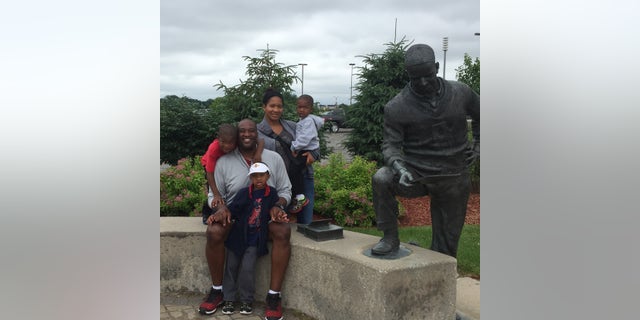
Former NFL star Keith Sims and his family made a pre-COVID motor home stop at Jack Trice Stadium located on the grounds of his alma mater, Iowa State University, in Ames, Iowa.
(Keith Sims)
The Georgia resident purchased a motor home in 2015 and has spent as many as 100 days a year since then traveling the road with his wife, Tia, and homeschooling their three boys, KJ, 13, Jayson, 11, and Justin, 10.
“When you fly from point to point,” he said, “you miss all the amazing stuff in between.”
Two months across America
The man who put the luxury home on wheels, Roland R. Conklin (1858-1938), was born in Urbana, Ill. He attended the University of Illinois and appeared to be a skillful business opportunist.
He launched his real estate career in Kansas City with his older brother, Stanley, and his business partner, Samuel Jarvis, forming the Jarvis-Conklin Mortgage & Trust Co. in the 1880s.
Conklin helped build Cuba’s transportation network after the U.S. victory in the Spanish-American War.
The Conklins moved their offices in the early 1890s to 40 Wall St. in New York City, now the site of the downtown Manhattan Trump Building.
There, “Roland R. Conklin became interested in the automobile and became an active member of the Automobile Club of America,” reported Coachbuilt, a trade publication that calls itself “the encyclopedia of coachbuilders and coachbuilding.”
BEGINNER’S GUIDE TO RV TRAILERS
His company was wiped out by the Panic of 1893, but it reorganized as the North American Trust Co., according to the National Cyclopaedia of American Biography.
Good fortune soon followed: “In 1898 this company was appointed fiscal agent for the U. S. government in Cuba, being the first American company to begin business on that island after the war with Spain.” Conklin’s company helped build Cuba’s transportation infrastructure.
He then created the Roland Gas-Electric Vehicle Corp. in 1913 to capitalize on America’s growing obsession with the automobile.
The drudgery that Conklin’s team and only a select few others ever experienced changed the course of American transportation.
The New York-to-California trip, which took Conklin two months, is now covered by commercial airliner in less than six hours. The drudgery that his team and only a select few others ever experienced changed the course of American transportation.
Young Army officer Dwight D. Eisenhower suffered a similarly difficult ordeal four years later. He embarked on a trip from Maryland to California with an Army convoy in 1919. The excursion took 62 days.
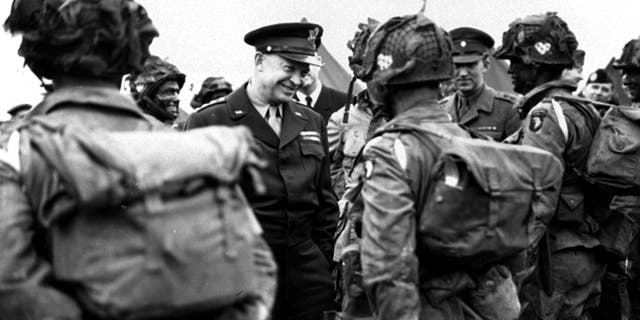
Gen. Dwight Eisenhower’s formative experiences crossing the U.S. on dreadful roads as a young Army officer — followed by his amazement at the German autobahn amid World War II — led to the creation of the Eisenhower Interstate Highway System during his 1950s presidency.
(U.S. Army Signal Corps Photo via AP)
The Lincoln Highway in Utah proved “one succession of dust, ruts, pits and holes,” Eisenhower wrote.
The dreadful journey on wheels across the American continent as a young man contrasted sharply with the awe General Eisenhower felt at the magnificent German autobahn during the defeat of the Nazis in 1945. The Allies turned the highways against the Germans late in the war, quickly flooding the fatherland with men and equipment.

The German autobahn was so wide, straight and flat that warplanes could land on it, a fact that impressed Supreme Allied Commander and future president Gen. Dwight Eisenhower.
(Supplied)
His experiences as both a junior and senior officer inspired President Eisenhower in the 1950s to create the Interstate Highway System, which now bears his name.
Wide, paved and limited access highways soon made every state in the lower 48 accessible to the average American family. The motor home pioneered by Conklin had found its medium.
‘Tin Can Tourists’
All motor homes are recreational vehicles. But not all RVs are motor homes.
Recreational vehicles, in industry parlance, also include towed trailers, which pre-date Conklin’s Gypsy Van motor home by at least a couple of years. The vast majority of RVs today are towed.

The Pierce-Arrow Touring Landau debuted at Madison Square Garden in 1910. It was the very first recreational vehicle.
(Public Domain)
The Pierce-Arrow Touring Landau, which debuted at Madison Square Garden in 1910, kicked off the RV industry. But it looked like little more than an SUV by today’s standards — while “the 1915 Gypsy Van is the first full-sized RV,” claimed MotorBiscuit.com, a sentiment shared with other industry sources.
The Earl Travel Trailer dates from 1913 and is on display at the RV/MH Hall of Fame in Indiana. It’s “believed to be the oldest non-tent travel trailer in existence.”
“As soon as motorized cars came along, people found ways to bring the comforts of home with them.”
“The Conestoga was the first RV,” joked GoRVing executive Karen Redfren, noting that the horse-drawn wagons that settled the west essentially transported entire homes.
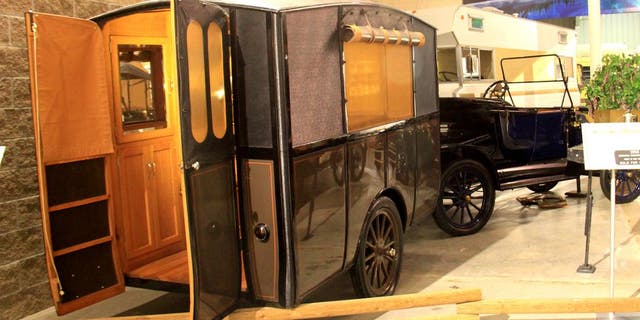
The oldest vehicle at the RV/MH Hall of Fame and Museum in Elkhart, Ind., is one of the nation’s earliest RVs, a trailer designed to bring the comforts of home on the road.
(RV/MH Hall of Fame)
“But as soon as motorized cars came along, people found ways to bring the comforts of home with them.”
Conklin’s Gypsy Van elevated the activity to a new level of leisure. It helped turn road-tripping, a hobby for the elite, into something more mainstream.
“The Tin Can Tourists, named because they heated tin cans of food on gasoline stoves by the roadside, formed the first camping club in the United States, holding their inaugural rally in Florida in 1919 and growing to 150,000 members by the mid-1930s,” Smithsonian reported in 2010, in its 100-year retrospective of the RV industry.
MEET THE AMERICAN WHO GAVE US THE DONUT
Hallmarks of American culture such as college football reflect the same passion with the motor home and RV today.
The sea of RVs at Penn State University on game day, to cite one example, appears to stretch out beyond eyesight over the undulations of the rural hills that surround its 107,000-seat pigskin palace Beaver Stadium.

The motor home parking lot outside Beaver Stadium at Penn State University is so large that it shows up as RV City on Google Maps.
(Kerry J. Byrne/Fox News Digital)
The arena’s motor home lot is so large it’s known as RV City on Google Maps. Its roads have their own unique grid-street designations. Tailgaters in RV City might park their vehicle at the intersection of RV West 3rd Avenue and RV Main Street, for example.
The COVID-19 pandemic only fueled America’s fever for the open road, said Redfren.
RV shipments skyrocketed during the crisis, from 406,000 in the pre-pandemic year of 2019 to a record 600,000 during the height of the scare in 2021, a spectacular increase of 48 percent in just two years. The average age of a first-time buyer dropped by a decade, to 33 years old.
“Being outdoors in a controlled environment with your family seemed like the safest place to be,” said Redfren of GoRVing.
The shocking rise in gas prices over the past year has failed to dampen America’s enthusiasm for taking their homes on the road, say industry experts. But it has changed habits.
The RV community notably is staying closer to home, the Sims family among them.
“The road is in my DNA.” — RV enthusiast John Ratzenberger
“Instead of driving somewhere like South Dakota, we’re driving around Georgia,” said Sims, the former Miami Dolphins Pro Bowl performer.
His boys were wowed by a recent trip to Georgia’s stunning Providence Canyon State Park, dubbed “The Little Grand Canyon” for its deep natural ravines.
Actor John Ratzenberger, mailman Cliff Clavin of the classic sitcom “Cheers” — and more recently the memorable voice in nearly two dozen Pixar films — is among the nation’s most notable celebrity RV enthusiasts.
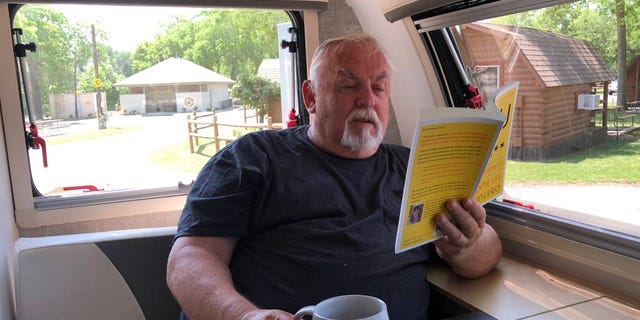
Actor John Ratzenberger of “Cheers” and Pixar films fame has traveled with an RV trailer much of his life, often responding to fan mail in person with his camper in tow.
(GoRVing.com)
“The road is in my DNA,” Ratzenberger told Fox News Digital, noting that his father was a truck driver for 36 years and that his children, Jim and Nina, spent much of their lives exploring the country with dad’s RV trailer in tow.
“They’re no strangers to truck stops,” the actor quipped.
Ratzenberger said he often hits the road to answer fan mail in person, knocking on doors across the country. He and son, Jim, showed up unexpectedly at one man’s door and ended up helping him install new kitchen cabinets.
“We just have fun on the road seeing what happens,” Ratzenberger said
Conklin’s end of the road
Roland Ray Conklin, the man who first conceived of America’s home on the road, died of pneumonia at Lenox Hill Hospital in Manhattan in 1938. He was 79 years old. He is buried at Huntington Rural Cemetery on Long Island.
“Was a motor bus advocate,” declared a headline in The New York Times obituary of him.
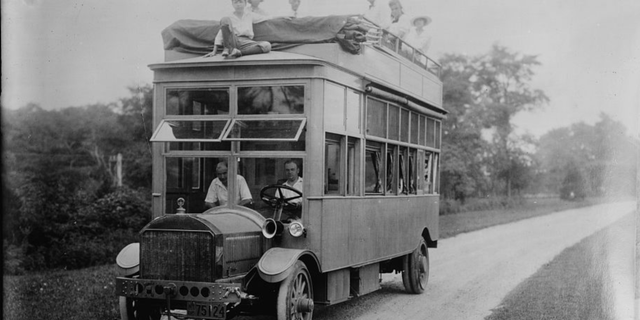
New York City entrepreneur and auto enthusiast Roland Conklin built the first full-fledged motor home with an array of modern luxuries, then drove it from Long Island to San Francisco.
(George Grantham Bain Collection)
The article noted that “he had not been active in business” since 1922.
Conklin sold his motorbus company in 1921 to “Chicago taxicab king” John D. Hertz, according to Coachbuilt.com.
MEET THE AMERICAN WHO HONORS THE MEMORY OF 200,000 FALLEN WAR HEROES
Yes, that would be the namesake of modern rental car giant Hertz. The windfall from the deal apparently afforded Conklin the luxury of retirement at age 63.
His iconic contribution to American culture was lavished as the “Motor Land Yacht” in his obituary.
CLICK HERE TO GET THE FOX NEWS APP
“The pictures of the vehicle suggests a Fifth Avenue bus of the next-to-last model with a roof garden on top. But the homelike equipment of the bus equaled all but the most luxurious of today’s trailers.”




